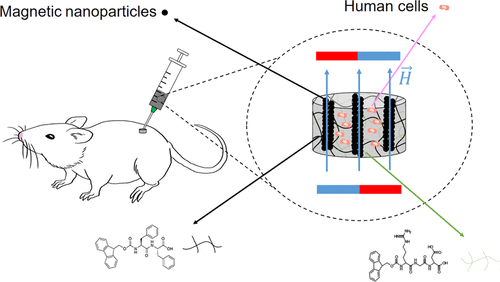当前位置:
X-MOL 学术
›
ACS Appl. Mater. Interfaces
›
论文详情
Our official English website, www.x-mol.net, welcomes your
feedback! (Note: you will need to create a separate account there.)
Injectable Magnetic-Responsive Short-Peptide Supramolecular Hydrogels: Ex Vivo and In Vivo Evaluation
ACS Applied Materials & Interfaces ( IF 8.3 ) Pub Date : 2021-10-14 , DOI: 10.1021/acsami.1c13972 Mari C Mañas-Torres 1, 2 , Cristina Gila-Vilchez 2, 3 , Francisco J Vazquez-Perez 3 , Pavel Kuzhir 4 , David Momier 5 , Jean-Claude Scimeca 5 , Arnaud Borderie 6 , Marianne Goracci 6 , Fanny Burel-Vandenbos 6 , Cristina Blanco-Elices 2, 7 , Ismael A Rodriguez 7, 8 , Miguel Alaminos 2, 7 , Luis Álvarez de Cienfuegos 1, 2 , Modesto T Lopez-Lopez 2, 3
ACS Applied Materials & Interfaces ( IF 8.3 ) Pub Date : 2021-10-14 , DOI: 10.1021/acsami.1c13972 Mari C Mañas-Torres 1, 2 , Cristina Gila-Vilchez 2, 3 , Francisco J Vazquez-Perez 3 , Pavel Kuzhir 4 , David Momier 5 , Jean-Claude Scimeca 5 , Arnaud Borderie 6 , Marianne Goracci 6 , Fanny Burel-Vandenbos 6 , Cristina Blanco-Elices 2, 7 , Ismael A Rodriguez 7, 8 , Miguel Alaminos 2, 7 , Luis Álvarez de Cienfuegos 1, 2 , Modesto T Lopez-Lopez 2, 3
Affiliation

|
The inclusion of magnetic nanoparticles (MNP) in a hydrogel matrix to produce magnetic hydrogels has broadened the scope of these materials in biomedical research. Embedded MNP offer the possibility to modulate the physical properties of the hydrogel remotely and on demand by applying an external magnetic field. Moreover, they enable permanent changes in the mechanical properties of the hydrogel, as well as alterations in the micro- and macroporosity of its three-dimensional (3D) structure, with the associated potential to induce anisotropy. In this work, the behavior of biocompatible and biodegradable hydrogels made with Fmoc-diphenylalanine (Fmoc-FF) (Fmoc = fluorenylmethoxycarbonyl) and Fmoc–arginine–glycine–aspartic acid (Fmoc-RGD) short peptides to which MNP were incorporated was studied in detail with physicochemical, mechanical, and biological methods. The resulting hybrid hydrogels showed enhance mechanical properties and withstood injection without phase disruption. In mice, the hydrogels showed faster and improved self-healing properties compared to their nonmagnetic counterparts. Thanks to these superior physical properties and stability during culture, they can be used as 3D scaffolds for cell growth. Additionally, magnetic short-peptide hydrogels showed good biocompatibility and the absence of toxicity, which together with their enhanced mechanical stability and excellent injectability make them ideal biomaterials for in vivo biomedical applications with minimally invasive surgery. This study presents a new approach to improving the physical and mechanical properties of supramolecular hydrogels by incorporating MNP, which confer structural reinforcement and stability, remote actuation by magnetic fields, and better injectability. Our approach is a potential catalyst for expanding the biomedical applications of supramolecular short-peptide hydrogels.
中文翻译:

可注射的磁响应短肽超分子水凝胶:体外和体内评估
在水凝胶基质中加入磁性纳米粒子 (MNP) 以生产磁性水凝胶,扩大了这些材料在生物医学研究中的范围。嵌入式 MNP 提供了通过施加外部磁场远程和按需调节水凝胶物理特性的可能性。此外,它们能够永久改变水凝胶的机械性能,以及改变其三维 (3D) 结构的微孔和大孔,并具有诱发各向异性的相关潜力。在这项工作中,研究了掺入 MNP 的 Fmoc-二苯丙氨酸 (Fmoc-FF) (Fmoc = 芴基甲氧羰基) 和 Fmoc-精氨酸-甘氨酸-天冬氨酸 (Fmoc-RGD) 短肽制成的生物相容性和可生物降解水凝胶的行为。物理化学,机械细节,和生物学方法。由此产生的混合水凝胶显示出增强的机械性能并经受住了注射而没有相破坏。在小鼠中,与非磁性对应物相比,水凝胶表现出更快和更好的自愈性能。由于这些优越的物理特性和培养过程中的稳定性,它们可以用作细胞生长的 3D 支架。此外,磁性短肽水凝胶表现出良好的生物相容性和无毒性,再加上其增强的机械稳定性和出色的可注射性,使其成为用于微创手术的体内生物医学应用的理想生物材料。本研究提出了一种通过结合 MNP 来改善超分子水凝胶物理和机械性能的新方法,这赋予了结构加固和稳定性、磁场远程驱动和更好的可注射性。我们的方法是扩展超分子短肽水凝胶生物医学应用的潜在催化剂。
更新日期:2021-10-27
中文翻译:

可注射的磁响应短肽超分子水凝胶:体外和体内评估
在水凝胶基质中加入磁性纳米粒子 (MNP) 以生产磁性水凝胶,扩大了这些材料在生物医学研究中的范围。嵌入式 MNP 提供了通过施加外部磁场远程和按需调节水凝胶物理特性的可能性。此外,它们能够永久改变水凝胶的机械性能,以及改变其三维 (3D) 结构的微孔和大孔,并具有诱发各向异性的相关潜力。在这项工作中,研究了掺入 MNP 的 Fmoc-二苯丙氨酸 (Fmoc-FF) (Fmoc = 芴基甲氧羰基) 和 Fmoc-精氨酸-甘氨酸-天冬氨酸 (Fmoc-RGD) 短肽制成的生物相容性和可生物降解水凝胶的行为。物理化学,机械细节,和生物学方法。由此产生的混合水凝胶显示出增强的机械性能并经受住了注射而没有相破坏。在小鼠中,与非磁性对应物相比,水凝胶表现出更快和更好的自愈性能。由于这些优越的物理特性和培养过程中的稳定性,它们可以用作细胞生长的 3D 支架。此外,磁性短肽水凝胶表现出良好的生物相容性和无毒性,再加上其增强的机械稳定性和出色的可注射性,使其成为用于微创手术的体内生物医学应用的理想生物材料。本研究提出了一种通过结合 MNP 来改善超分子水凝胶物理和机械性能的新方法,这赋予了结构加固和稳定性、磁场远程驱动和更好的可注射性。我们的方法是扩展超分子短肽水凝胶生物医学应用的潜在催化剂。











































 京公网安备 11010802027423号
京公网安备 11010802027423号